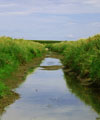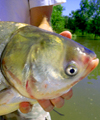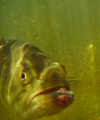Current research projects
Using physiological tools to assist with ecological restoration
 Freshwater fishes around the globe are experiencing alarming rates of population declines, and one of the largest factors contributing to these declines is habitat destruction. Consequently, there are a number of approaches available to restore damaged ecosystems to allow fish populations to recover. Our research in this area seeks to use physiological tools to understand the responses of individual fish and fish populations to landscape-level disturbances. Such knowledge can assist the development and implementation of effective restoration strategies that recognize the role of habitat quality on organismal performance. Furthermore, physiological tools can be used to monitor the success of restoration projects during their implementation and as part of post-project monitoring. This research is being carried out at locations around Illinois, as well as along the St. Lawrence River in Ontario, Canada.
Freshwater fishes around the globe are experiencing alarming rates of population declines, and one of the largest factors contributing to these declines is habitat destruction. Consequently, there are a number of approaches available to restore damaged ecosystems to allow fish populations to recover. Our research in this area seeks to use physiological tools to understand the responses of individual fish and fish populations to landscape-level disturbances. Such knowledge can assist the development and implementation of effective restoration strategies that recognize the role of habitat quality on organismal performance. Furthermore, physiological tools can be used to monitor the success of restoration projects during their implementation and as part of post-project monitoring. This research is being carried out at locations around Illinois, as well as along the St. Lawrence River in Ontario, Canada.
Movement of Asian carp: using ecology and physiology to control spread
 Invasive Asian carp have the potential to cause tremendous ecological damage should they pass from the Mississippi River into the Great Lakes Basin. Our research group is working to deter the movement of Asian carp using two separate approaches. First, we are using physiological tools to define patterns of movement, activity and spread of Asian carp across the midwest. Results from this line of research will improve our understanding of the factors motivating Asian carp to spread to new environments. Second, we are researching alternate aquatic barriers that can help deter the movement of Asian carp and prevent their spread into the Great Lakes. For this, we are quantifying the response of Asian carp to a range of potential barrier substances, and quantifying the response of Asian carp at scales that range from gene expression to movement using three-dimensional telemetry.
Invasive Asian carp have the potential to cause tremendous ecological damage should they pass from the Mississippi River into the Great Lakes Basin. Our research group is working to deter the movement of Asian carp using two separate approaches. First, we are using physiological tools to define patterns of movement, activity and spread of Asian carp across the midwest. Results from this line of research will improve our understanding of the factors motivating Asian carp to spread to new environments. Second, we are researching alternate aquatic barriers that can help deter the movement of Asian carp and prevent their spread into the Great Lakes. For this, we are quantifying the response of Asian carp to a range of potential barrier substances, and quantifying the response of Asian carp at scales that range from gene expression to movement using three-dimensional telemetry.
Defining factors that result in vulnerability to angling for fish
 The vulnerability of fish to being captured by anglers is a heritable trait, and different individuals within a population are believed to have different likelihoods of being captured by a lure. The vulnerability of fish to being captured likely results from a combination of physiological, behavioral and metabolic characteristics of each individual fish. Our research in this area seeks to identify the factors that explain why fish are vulnerable to angling, and how this can vary across species. Results will have important implications for managing recreational fisheries, setting harvest limits, and conserving valuable recreational fisheries.
The vulnerability of fish to being captured by anglers is a heritable trait, and different individuals within a population are believed to have different likelihoods of being captured by a lure. The vulnerability of fish to being captured likely results from a combination of physiological, behavioral and metabolic characteristics of each individual fish. Our research in this area seeks to identify the factors that explain why fish are vulnerable to angling, and how this can vary across species. Results will have important implications for managing recreational fisheries, setting harvest limits, and conserving valuable recreational fisheries.
Past research projects
Control of invasive lake trout populations in Yellowstone Lake
 Invasive lake trout represent a major threat to populations of Yellowstone cutthrouat trout in Yellowstone Lake. By reducing the numbers of Yellowstone cutthroat trout, invasive lake trout have the potential to negatively impact both aquatic and terrestrial ecosystems in Yellowstone National Park. We are part of a multi-disciplinary team
working to eradicate invasive lake trout from Yellowstone Lake. Our role is primarily related to fish telemetry, and is intended to help define spawning shoals where lake trout reproduce. The identification of spawning shoals will allow harvesters to efficiently remove lake trout during spawning aggregations, and will also help identify areas of Yellowstone Lake for removal of eggs/embryos. In this way, telemetry can help provide information on the activity and reproductive patterns of lake trout, and thereby facilitate removal efforts.
Invasive lake trout represent a major threat to populations of Yellowstone cutthrouat trout in Yellowstone Lake. By reducing the numbers of Yellowstone cutthroat trout, invasive lake trout have the potential to negatively impact both aquatic and terrestrial ecosystems in Yellowstone National Park. We are part of a multi-disciplinary team
working to eradicate invasive lake trout from Yellowstone Lake. Our role is primarily related to fish telemetry, and is intended to help define spawning shoals where lake trout reproduce. The identification of spawning shoals will allow harvesters to efficiently remove lake trout during spawning aggregations, and will also help identify areas of Yellowstone Lake for removal of eggs/embryos. In this way, telemetry can help provide information on the activity and reproductive patterns of lake trout, and thereby facilitate removal efforts.
Impacts of climate change on nearshore marine communities
 Climate change has the potential to negatively impact marine organisms due to changes in water temperature, salinity and pH (acidity). To date, most research in this area has focused on the impacts of climate change on either shell-forming organisms or coral reef fishes, and has shown that slight alterations to ocean chemistry can have pronounced impacts on marine organisms. Our research is working to quantify the impacts of climate change on nearshore marine fishes that inhabit mangroves. Or work is using both physiological and behavioral tools to assess how mangrove fishes respond to climate-related stressor that include increased water temperature, increased salinity and reduced pH. This work is being carried out at the Cape Eleuthera Institute, on the island of Eleuthera, The Bahamas.
Climate change has the potential to negatively impact marine organisms due to changes in water temperature, salinity and pH (acidity). To date, most research in this area has focused on the impacts of climate change on either shell-forming organisms or coral reef fishes, and has shown that slight alterations to ocean chemistry can have pronounced impacts on marine organisms. Our research is working to quantify the impacts of climate change on nearshore marine fishes that inhabit mangroves. Or work is using both physiological and behavioral tools to assess how mangrove fishes respond to climate-related stressor that include increased water temperature, increased salinity and reduced pH. This work is being carried out at the Cape Eleuthera Institute, on the island of Eleuthera, The Bahamas.
Impacts of rain-driven hypoxia on fishes in an urban setting
 Point and nonpoint discharges from storm (wet weather) events are a significant cause of pollution inputs and poor water quality in urban environments. In particular, oxygen-depleting substances discharged to or resuspended within receiving waters during wet weather events are considered one of the leading pollutants affecting urban waters. Oxygen depletion resulting from wet weather event persist for days or weeks after a rain storm. The effects of these depletions of dissolved oxygen in urban environments remain difficult to assess but are believed to have negative impacts on aquatic communities. The objective of this study is to quantify the impact of wet weather-induced reductions in dissolved oxygen on the behavior and physiology of fishes using field- and laboratory-derived data, and to use this information to further develop guidelines that could protect and enhance aquatic life. To accomplish this, we are conducting a pilot study that uses a combination of (1) stationary acoustic telemetry arrays to quantify the movements of free-swimming fish relative to dissolved oxygen concentration, and (2) laboratory experiments that recreate concentrations of dissolved oxygen observed in the field to quantify the sub-lethal, physiological impacts hypoxia on largemouth bass. This research is being carried out in the Chicago Area Waterways System.
Point and nonpoint discharges from storm (wet weather) events are a significant cause of pollution inputs and poor water quality in urban environments. In particular, oxygen-depleting substances discharged to or resuspended within receiving waters during wet weather events are considered one of the leading pollutants affecting urban waters. Oxygen depletion resulting from wet weather event persist for days or weeks after a rain storm. The effects of these depletions of dissolved oxygen in urban environments remain difficult to assess but are believed to have negative impacts on aquatic communities. The objective of this study is to quantify the impact of wet weather-induced reductions in dissolved oxygen on the behavior and physiology of fishes using field- and laboratory-derived data, and to use this information to further develop guidelines that could protect and enhance aquatic life. To accomplish this, we are conducting a pilot study that uses a combination of (1) stationary acoustic telemetry arrays to quantify the movements of free-swimming fish relative to dissolved oxygen concentration, and (2) laboratory experiments that recreate concentrations of dissolved oxygen observed in the field to quantify the sub-lethal, physiological impacts hypoxia on largemouth bass. This research is being carried out in the Chicago Area Waterways System.
Linking reproduction with conservation for nesting bass
 Male largemouth bass and smallmouth bass provide parental care for their developing offspring in the form of egg fanning and defense from predators. Across North America there is a great deal of variation in regulations designed to protect nesting bass from angling - some areas have closed seasons preventing all angling for nesting bass, while some areas allow angling for nesting bass. Each of these two management options makes different assumptions about the impacts of angling for nesting bass. My research in this area worked to understand the individual- and population-level consequences of angling for nesting bass while they are guarding their broods. My research showed that if brood-guarding bass are targeted by anglers, the fish that will be caught are not selected randomly - large males with large broods defend their nests more aggressively than small males and will be preferentially caught. Over time, this can lead to a reduction in population size and reproductive output if small large males are repeatedly angled and acheive reduced fitness. As a result of this research, showed that no-fishing sanctuaries can work to increase population-level reproductive success for nesting bass populations. This research was carried out at lakes in the vicinity of the Queen's University Biological Station.
Male largemouth bass and smallmouth bass provide parental care for their developing offspring in the form of egg fanning and defense from predators. Across North America there is a great deal of variation in regulations designed to protect nesting bass from angling - some areas have closed seasons preventing all angling for nesting bass, while some areas allow angling for nesting bass. Each of these two management options makes different assumptions about the impacts of angling for nesting bass. My research in this area worked to understand the individual- and population-level consequences of angling for nesting bass while they are guarding their broods. My research showed that if brood-guarding bass are targeted by anglers, the fish that will be caught are not selected randomly - large males with large broods defend their nests more aggressively than small males and will be preferentially caught. Over time, this can lead to a reduction in population size and reproductive output if small large males are repeatedly angled and acheive reduced fitness. As a result of this research, showed that no-fishing sanctuaries can work to increase population-level reproductive success for nesting bass populations. This research was carried out at lakes in the vicinity of the Queen's University Biological Station.